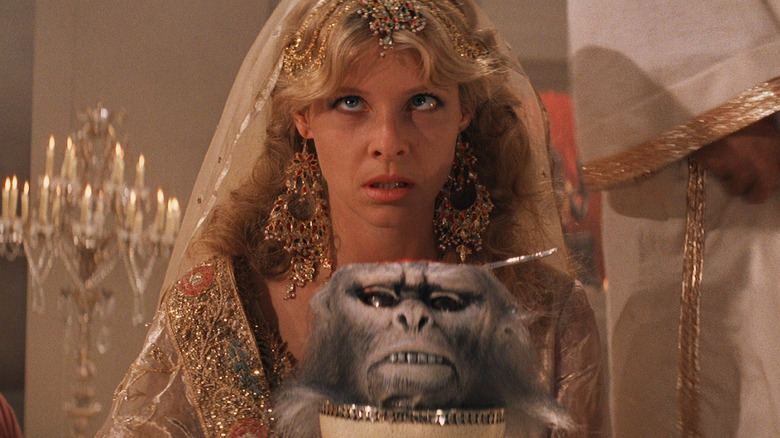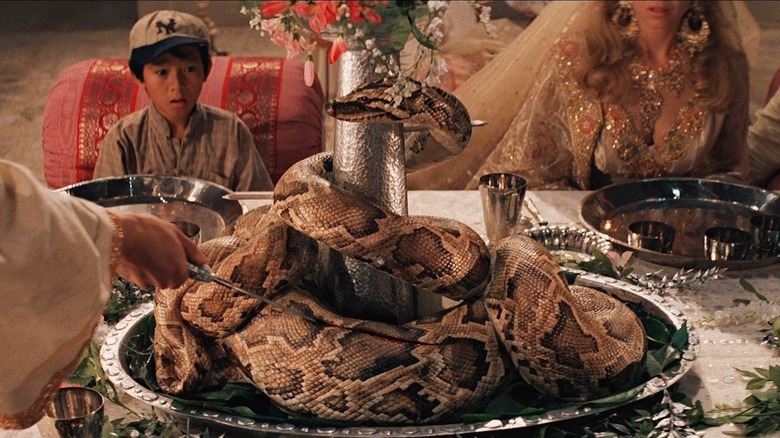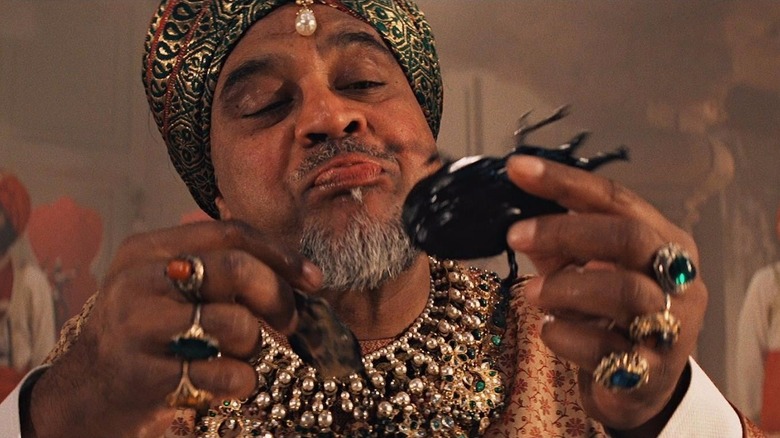Indiana Jones And The Temple Of Doom's Criticized Banquet Scene Was Supposed To Be A Joke
Steven Spielberg's 1984 blockbuster "Indiana Jones and the Temple of Doom" is not a good movie. The pacing is strange, the central story is introduced rather late into the film, and the interior logic doesn't really stand up to scrutiny. Many also take issue with Willie Scott (Kate Capshaw) as she constantly whines. Also what is the true nature of the Sankara stones, and why is it bad that Mola Ram (Amrish Puri) has them? It seems that Mola Ram and Chattar Lal (Roshan Seth) are quite evil enough merely enslaving hundreds of children to work in their mines.
"Temple of Doom" is also the bloodiest and scariest of the "Indiana Jones" movies, a quality that both Spielberg and story writer/producer George Lucas have said was inspired by their respective messy breakups at the time. While many find the movie's gore to be fun and zesty — including this author — it made "Temple of Doom" off-putting to many fans of its predecessor, 1981's "Raiders of the Lost Ark."
Most notorious, however, is a scene near the film's middle wherein Willie, Indiana Jones (Harrison Ford), and their young companion Short Round (Ke Huy Quan), are invited to dine with the Maharajá of Pankot (Raj Singh) at his palace. The meal, however, is cartoonishly gross, featuring imaginary "gross" dishes invented to frighten the audience. Willie is served massive actaeon beetles, live snakes (cut fresh from their mother's womb), eyeball soup, and chilled monkey brains. "Temple of Doom" has often been accused of perpetuating racist stereotypes, and not just because of the dinner scene.
In a 2012 issue of Empire Magazine, Seth explained that the "gross food" scene was meant to be a sendup of the main characters' assumptions and not a stereotype of Indian people. Sadly, the gag didn't play.
Snake Surprise
The scene, for 2023 audiences, may be difficult to sit through. Those who aren't put off by gross foods will likely be made uncomfortable with the caricatures. A character credited only as Merchant #1 (Ahmed El-Shenawi) looks eagerly at the Snake Surprise, while Merchant #2 (Zalim Singh) slurps down the actaeon beetles with savor, belching in comfort. The scene plays into a "foreigners eat weird things" trope that is all too persistent in modern entertainment. Rather than look up the cuisine of India, the filmmakers decided to "other" the Indian people by forcing them to eat live snakes and eyeballs. The misrepresentation of the Indian people caused "Temple of Doom" to be temporarily banned in the country.
Seth recalls the controversy and went on record defending the scene as a gag about racism, rather than being outright racist. He does note, however, that the gag wasn't presented very well and, as such, wasn't understood by anyone. The actor said:
"The banquet scene was a joke that went wrong. I got a great deal of flak for it because people kept saying, 'How does an intelligent man like you agree to be in a film which shows Indians dining on beetles and eels?' Steven intended it as a joke, the joke being that Indians were so f***ing smart that they knew all Westerners think that Indians eat cockroaches, so they served them what they expected. The joke was too subtle for that film."
Perhaps if Chattar Lal had a brief scene where he whispered to the other Indian characters that they were going to play a prank on the visiting Ugly Americans by serving them bugs and eyeballs — and if the Indian characters didn't eat those foods with enthusiasm — the joke would have worked.
It didn't.
I had bugs for lunch
Incidentally, the Snake Surprise prop used in "Indiana Jones and the Temple of Doom" was up for auction several years back on a movie memorabilia website. It didn't sell.
Seth and the film's other Indian actors, meanwhile, seem to have understood that they were performing in a broad, Americanized view of India, rather than a production that sought authenticity. Indiana Jones was a worldly, globe-trotting character, but the filmmakers didn't seem to share that quality. They wanted gags, adventure, and larger-than-life characters. Seth recalls working with Amrish Puri, whose Mola Ram was a grinning, wicked villain of the highest order. Puri, incidentally, starred in hundreds of films in India. Seth recalled:
"Amrish Puri, who played Mola Ram, was a very nice guy. He was operatic; he couldn't have been a better villain. But I have to say this: Indian people are very embarrassed when they see one of their own playing roles like that."
"Temple of Doom" opened to terrible reviews. There was enormous feminist criticism of Willie Scott, and, as mentioned, the film was briefly banned in India. For many years, at least after the release of "Indiana Jones and the Last Crusade" in 1989, "Temple of Doom" was considered a distant third in terms of quality. It was only after the release of "Indiana Jones and the Kingdom of the Crystal Skull" in 2008 that the second film's reputation could be salvaged. Or at least, the film could claim to no longer be the worst in the series. Nowadays, it's at least third-best.
Cards on the table: There are two good "Indiana Jones" movies.


